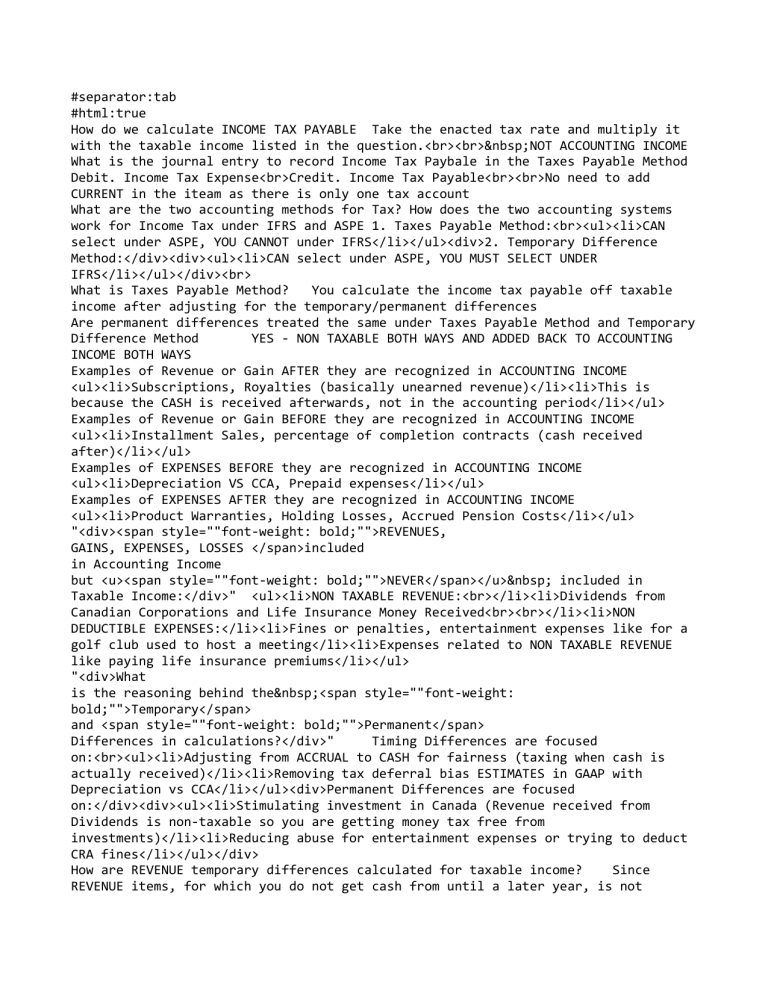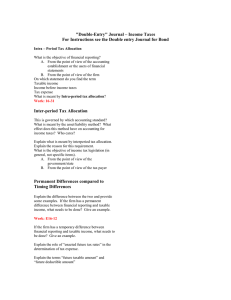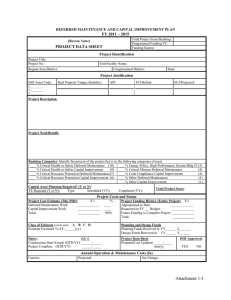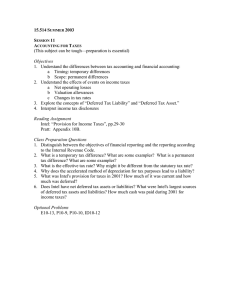
#separator:tab #html:true How do we calculate INCOME TAX PAYABLE Take the enacted tax rate and multiply it with the taxable income listed in the question.<br><br>&nbsp;NOT ACCOUNTING INCOME What is the journal entry to record Income Tax Paybale in the Taxes Payable Method Debit. Income Tax Expense<br>Credit. Income Tax Payable<br><br>No need to add CURRENT in the iteam as there is only one tax account What are the two accounting methods for Tax? How does the two accounting systems work for Income Tax under IFRS and ASPE 1. Taxes Payable Method:<br><ul><li>CAN select under ASPE, YOU CANNOT under IFRS</li></ul><div>2. Temporary Difference Method:</div><div><ul><li>CAN select under ASPE, YOU MUST SELECT UNDER IFRS</li></ul></div><br> What is Taxes Payable Method? You calculate the income tax payable off taxable income after adjusting for the temporary/permanent differences Are permanent differences treated the same under Taxes Payable Method and Temporary Difference Method YES - NON TAXABLE BOTH WAYS AND ADDED BACK TO ACCOUNTING INCOME BOTH WAYS Examples of Revenue or Gain AFTER they are recognized in ACCOUNTING INCOME <ul><li>Subscriptions, Royalties (basically unearned revenue)</li><li>This is because the CASH is received afterwards, not in the accounting period</li></ul> Examples of Revenue or Gain BEFORE they are recognized in ACCOUNTING INCOME <ul><li>Installment Sales, percentage of completion contracts (cash received after)</li></ul> Examples of EXPENSES BEFORE they are recognized in ACCOUNTING INCOME <ul><li>Depreciation VS CCA, Prepaid expenses</li></ul> Examples of EXPENSES AFTER they are recognized in ACCOUNTING INCOME <ul><li>Product Warranties, Holding Losses, Accrued Pension Costs</li></ul> "<div><span style=""font-weight: bold;"">REVENUES, GAINS, EXPENSES, LOSSES </span>included in Accounting Income but <u><span style=""font-weight: bold;"">NEVER</span></u>&nbsp; included in Taxable Income:</div>" <ul><li>NON TAXABLE REVENUE:<br></li><li>Dividends from Canadian Corporations and Life Insurance Money Received<br><br></li><li>NON DEDUCTIBLE EXPENSES:</li><li>Fines or penalties, entertainment expenses like for a golf club used to host a meeting</li><li>Expenses related to NON TAXABLE REVENUE like paying life insurance premiums</li></ul> "<div>What is the reasoning behind the&nbsp;<span style=""font-weight: bold;"">Temporary</span> and <span style=""font-weight: bold;"">Permanent</span> Differences in calculations?</div>" Timing Differences are focused on:<br><ul><li>Adjusting from ACCRUAL to CASH for fairness (taxing when cash is actually received)</li><li>Removing tax deferral bias ESTIMATES in GAAP with Depreciation vs CCA</li></ul><div>Permanent Differences are focused on:</div><div><ul><li>Stimulating investment in Canada (Revenue received from Dividends is non-taxable so you are getting money tax free from investments)</li><li>Reducing abuse for entertainment expenses or trying to deduct CRA fines</li></ul></div> How are REVENUE temporary differences calculated for taxable income? Since REVENUE items, for which you do not get cash from until a later year, is not taxable. <br><br>This is SUBTRACTED from the ACCOUNTING INCOME. (Temp difference). Added back to the year when the cash is actually received. How are EXPENSE temporary differences calculated for taxable income? <ul><li>EXPENSES that are NOT deductible in the year are ADDED back.</li><li>Only SUBTRACTED for the year the service was provided for example WARRANTY REPAIRS in a later year</li></ul> How are PERMANENT differences treated when calculating taxable income? ADD them back to the accounting income no matter what year.<br><br>Permanent differences will always INCREASE the taxable income, therefore it has to be added back. What happens when a corporation is OWED a Income Tax Refund, what are the Journal Entries and where on the financial statements do the items go? Debit. Income Tax Receivable (Current Asset)<br>Credit. Income Tax Benefit (ADDED to accounting income BEFORE calculating income tax) <div><strong>Income Statement: How does tax expense affect the statement in each Taxes Payable vs. Temporary Difference Methods</strong><br></div> "<ul><li>The starting method for both methods would be the Income Before Tax</li></ul><div><div><strong>Taxes Payable Method (Only ASPE has this option)</strong>:</div><ul><li>Only uses ""<strong>Income Tax Expense/(Benefit)</strong>"". No need for ""current"" in the name. SUBTRACT expense and ADD benefit<br></li></ul><div><div><strong>Temporary Difference Method (Only IFRS, Optional ASPE)</strong>:</div><ul><li>Uses ""<strong>Current Income Tax Expense/(Benefit)</strong>"" to distinguish it from the other account.</li><li>Also has ""<strong>Deferred Income Tax Expense/(Benefit)</strong>"".</li></ul></div></div>" Where do the items go under the BALANCE SHEET under Taxes Payable Method If a LIABILITY:<br><ul><li>CURRENT LIABILITY: Income Tax Payable<br></li></ul><div>If a ASSET:</div><div><ul><li>CURRENT ASSET: Income Tax Receivable (when a tax refund is received)</li></ul></div> Where do the items go under the BALANCE SHEET under Temp Difference Method If a LIABILITY:<br><ol><li>LONG TERM LIABILITY: Deferred Income Tax Liability<br></li></ol><div>If an ASSET:</div><div><ul><li>LONG TERM ASSET: Deferred Income Tax Asset</li></ul></div> What is the Deferred Income Tax expense based on? What is the definition of this. All the CHANGES made to either Deferred Income Tax LIABILITY or ASSET during the accounting period only<br><br>FUTURE tax CONSEQUENCE of a taxable temporary difference TODAY How would Deferred Tax Expense be calculated from a Liability in a period? Explain the journal entry after calculation. For example, if a company had sales revenue for $30,000 in a year, they are goin to receive that cash in the future.<br><br>For the $30,000. We take the enacted tax rate of 25% and multiply it:<br><ul><li>30,000 x 25% = 7,500<br></li></ul><div>The Deferred Income Tax expense for the year is 7,500<br><br>Debit. Deferred Income Tax Expense<br>Credit. Deferred Income Tax Liability</div> What happenes to the Deferred Income Liability account during the years cash is actually received for the Sales Revenue? Explain the Journal Entries for each time cash is received. We take the amount of actual cash received (in the next year it is 20,000).<br><br>Multiply that with the tax rate:<br><ul><li>20,000 x 25% = 5,000</li></ul><div>When the cash is received and tax is calculated:<br><ul><li>Debit. Deferred Income Tax Liability (This time reducing the liability as the impact of future tax lowers)</li><li>Credit. Deferred Income Tax Benefit</li></ul></div> How to calculated TOTAL income tax expense from Income Tax Payable and Deferred Income Tax (what is the formula)<br> Income Tax Payable = 100<br><br>Deferred Tax Expense:<br>Deferred Tax Liability/Asset, end of year&nbsp; = 50<br>LESS: Deferred Tax Liability/Asset, Beginning = (25)<br><br>Total Deferred Tax Liability/Asset, Total for year = 25<br> Calculation for TOTAL Deferred Tax Asset or Liability the way the teacher said = Future Deductible or Taxable amount x Tax Rate<br><ul><li>This calculation is for each year</li><li>Add all the the amounts to get the total for Deferred Tax Asset/Liability for the YEAR it was SOLD OR BOUGHT<br>&nbsp; &nbsp; &nbsp; &nbsp;&nbsp;<br></li></ul> What is the journal entry for TOTAL Deferred Tax Asset and its ONE-year adjustment? Total for All Years:<br>Debit. Deferred Tax Asset<br>Credit. Deferred Tax Benefit<br><br>One Year:<br>Debit. Deferred Tax Expense&nbsp;<br>Credit. Deferred Tax Asset What is the journal entry for TOTAL Deferred Tax LIABILITY and its ONE-year adjustment? For TOTAL:<br>Debit. Deferred Tax Expense<br>Credit. Deferred Tax Liability<br><br>For ONE YEAR:<br>Debit. Deferred Tax Liability<br>Credit. Deferred Tax Benefit What is the journal entry when there are multiple differences? (Both revenue and expense in same year) If LIABILITY &gt; ASSET:<br><ul><li>Debit. Deferred Tax Expense</li><li>Credit. Deferred Tax Liability<br></li></ul><div>If ASSET &gt; LIABILITY:</div><div><ul><li>Debit. Deferred Tax Asset</li><li>Credit Deferred Tax Benefit</li></ul></div> How to calculate EFFECTIVE tax rate = Total Income Tax Expense / Accounting Income What do you do when there is a tax rate change in the future Recognize the increase or decrease in the Deferred Tax Asset/Liability account with a journal entry How often is a Deferred Tax Asset account reviewed, what happens when the account can't generate enough money? One every year end to determine if any changes need to be made to the carrying amount<br><br>If it is unlikely that sufficient taxable income will be generataed from the Income Tax Asset then it may be written down How should Deferred Tax Assets/Liabilities be reported on B/S by both ASPE and IFRS IFRS:<br><ul><li>Requires all Deferred Items to be reported as long-term (non-current)<br></li></ul><div>ASPE:</div><div><ul><li>Future Income Tax items will be separated based on the timing differences and when they will reverse (either within a year or longer?)<br></li></ul><div>Under BOTH:<br><ul><li>Deferred Income Assets/Liabilities can be netted within the SAME corporation</li><li>CANT be netted in consolidated financial statements</li></ul></div></div> How to treat Intra-Period tax allocation Allocated vertically through the income statement and OCI in a given year Tax disclosure requirements for IFRS and ASPE ASPE:<br><ul><li>Limited disclosures</li></ul><div>IFRS:<br><ul><li>Sources of both current and deferred income taxes</li><li>Amount of current and deferred income tax recognized in equity</li><li>Reconciliation of effective tax rates</li><li>Information about unrecognized Deferred Income Tax Assets</li><li>Information about each tpe of Temp Difference&nbsp;</li></ul></div> How do investors view the deferred tax amounts They are often ignored by investors due to the information being misleading:<br><ul><li>Timing of realization is questionable</li><li>Mnay are created based on estimates</li><li>They dont represent a true monetary asset that can be sold or liability that will be paid</li></ul> What does it mean when it says the UCC is LOWER than the net carrying amount in the question? Seems to be a fancy way of saying CCA &gt; Depreciation<br><br>Which leads to SUBTRACTING from accounting income What to do when CCA is HIGHER than the&nbsp; book value depreciation under IFRS<br><br>Prepare the journal entries "<span style=""color: rgb(255, 255, 255);"">SUBTRACT&nbsp;From&nbsp;the&nbsp;accounting&nbsp;income</span><br>Deferred tax LIABILITY<br><br>HOW TO CALCULATE:<br>CCA Excess x Tax Rate = Deferred Tax LIABILITY<br><br>Debit. Deferred Tax Expense<br>Credit. Deferred Tax Liability" How to handle calculating accounting income FROM taxable income, specifically with these items<br><br>- Dividend Income<br>- Excess of CCA OVER depreciation&nbsp;<br>- Unearned rent STARTING POINT = Taxable Income<br><ul><li>ADD back dividend income</li><li>ADD back the excess CCA over depreciation</li><li>SUBTRACT the unearned rent</li></ul><div>ENDING POINT (ANSWER) = Accounting Income&nbsp;</div> How to calculate the effective rate off of multiple differences in ONE year 1. Take the accounting income and multiply by tax rate<br>2. Take the NON DEDUCTIBLE insurance expense and multiply that with the tax rate<br><br>Divide the tax payable for each item with the accounting income to get the percentage. THEN WE ADD THE PERCENTAGES (25% + 0.8% = 25.8%) What formula do they want you to remember for Tax Base and Deferred Tax Asset calculation Tax Base - Carrying Amount = Deductible Temp Difference x Tax Rate = Deferred Tax Asset&nbsp; How to calculate the increase in deferred tax when the tax rate increases in the future?<br><br>For example: 25% in 2020 and then 30% in 2023 First get the difference in increase, in this case it is 5%<br><br>Multiply the difference with the year reversible amount the tax rate changed (in this case 2023).&nbsp;<br>(352,000 x 5% = 17,600 increase to TOTAL) What to do when the company will not realize a certain amount in deferred tax asset? Prepare the journal entries for both scenarios<br><br>A) Assuming they DO NOT use a valuation account<br>B) Assuming they DO use a valuation account A) DO NOT USE ACCOUNT<br>Debit. Deferred Tax Expense (..amount not realized..)<br>Credit. Deferred Tax Asset (..amount not realized..)<br><br>B) USE ACCOUNT<br>Debit. Deferred Tax Expense (..amount not realized..)<br>Credit. Allowance to Reduce Deferred Tax Asset to Expected Realizable Value (..amount not realized..) How is a trademark that is acquired from the government and capitalized over a period of time treated for tax purposes? It will be a reversing difference, and this will be a deferred tax liability How is a prepaid advertising expense that is deferred for ACCOUNTING purposes and deducted as an expense for TAX purposes treated? Reversing difference, and it is treated as a deferred tax LIABILITY How to classify between deferred tax LIABILITY vs ASSET LIABILITY:<br><ul><li>If recovery of an asset or settlement of a liability will result in the company paying MORE income taxes in the future, then a liability is recognized<br></li></ul><div>ASSET:</div><div><ul><li>If recovery of an asset or settlement of a liability will result in the company paying LESS tax in the future, then asset is recognized</li></ul></div> How to treat holdings GAINS and LOSSES under deferred tax, not taxable until realized GAINS:&nbsp;<br><ul><li>future TAXABLE income</li><li>deferred tax LIABILITY as it will increase accounting income<br></li></ul><div>LOSSES:</div><div><ul><li>future DEDUCTIBE</li><li>deferred tax ASSET as it will lower accounting income</li></ul></div>




